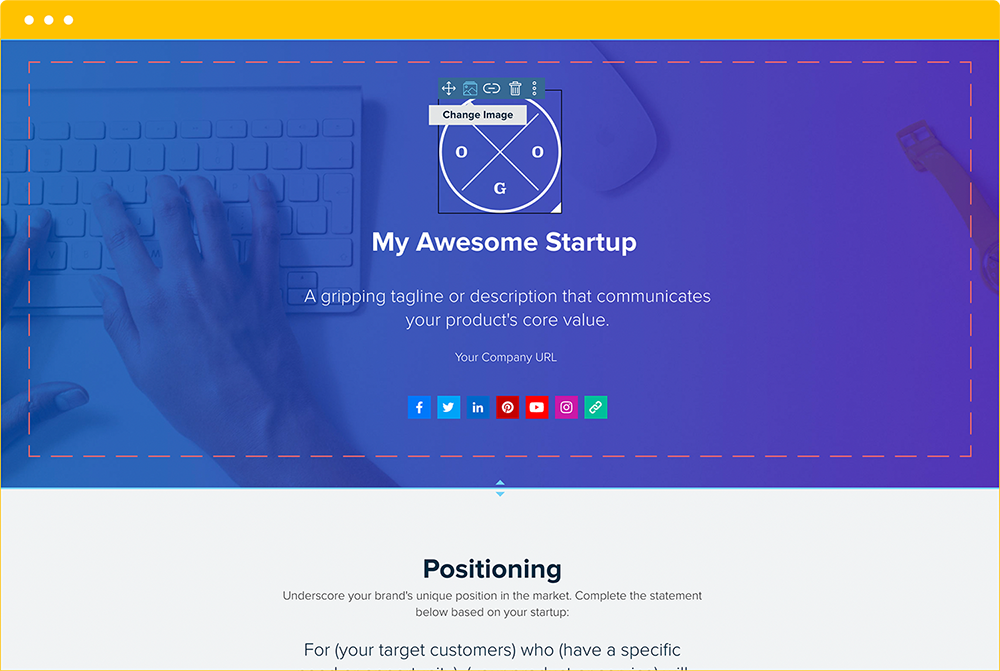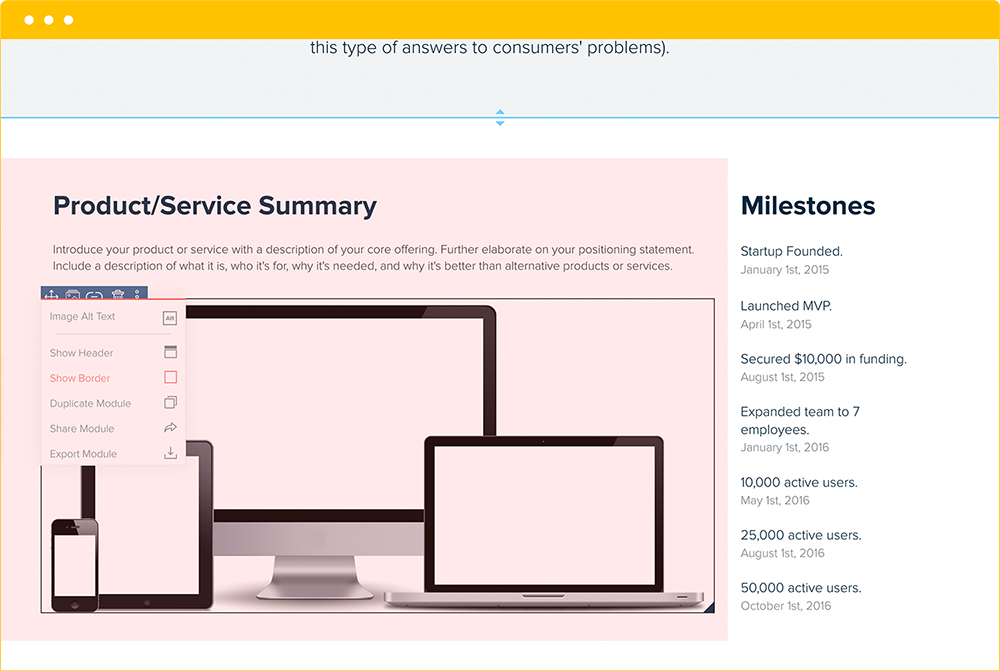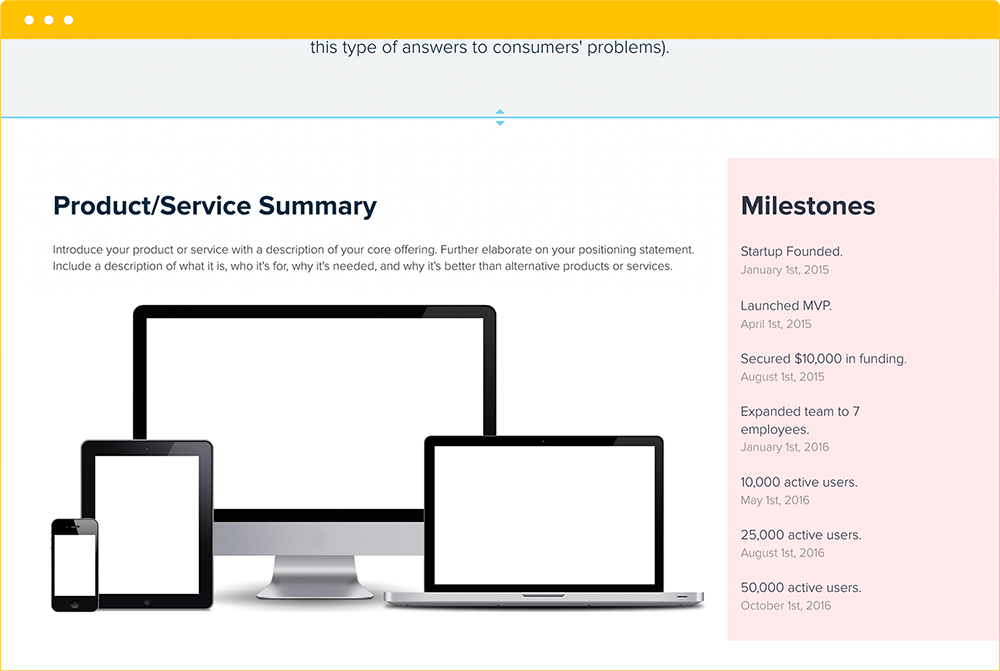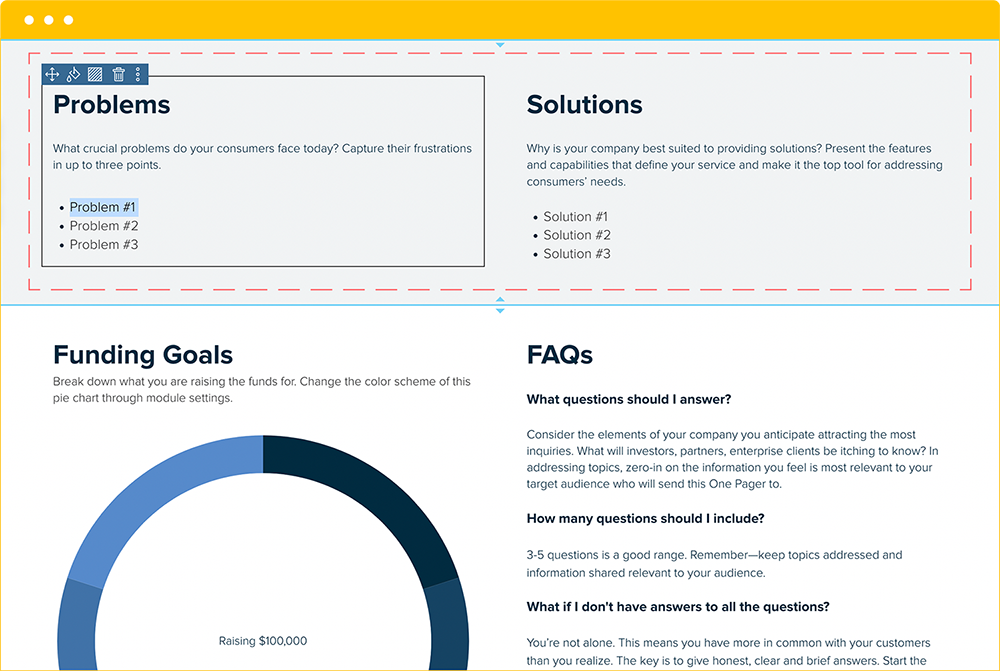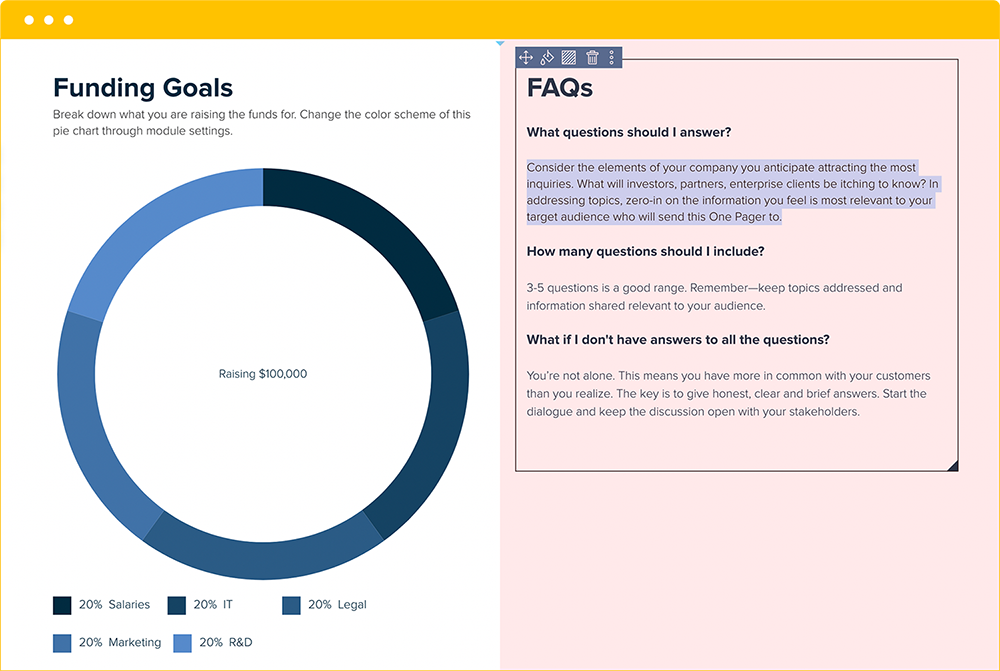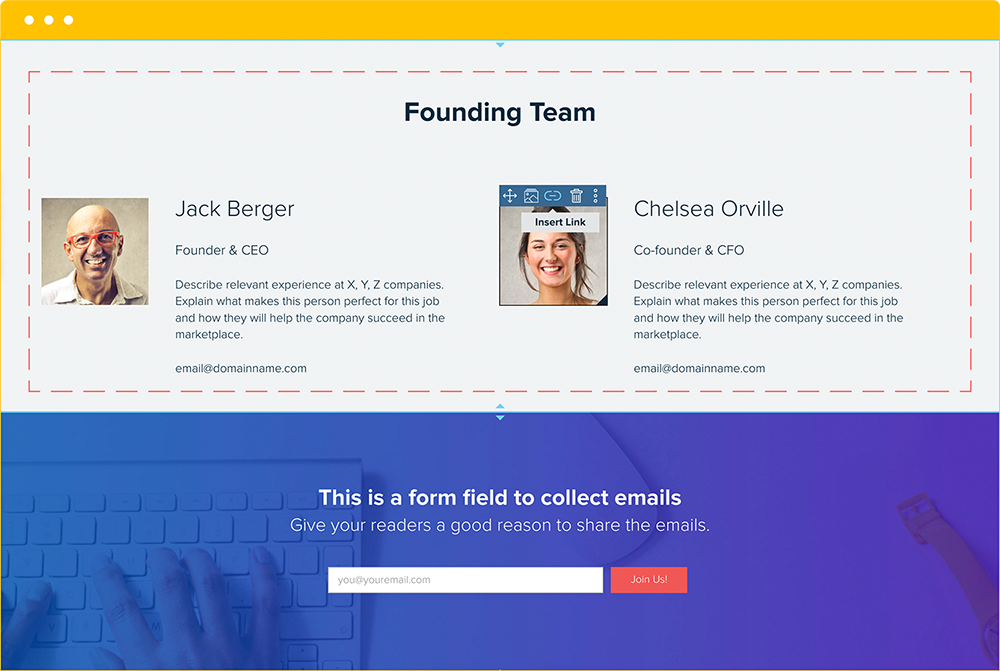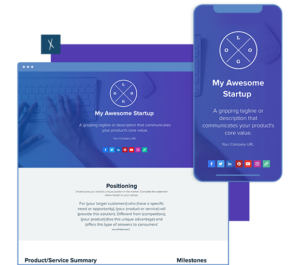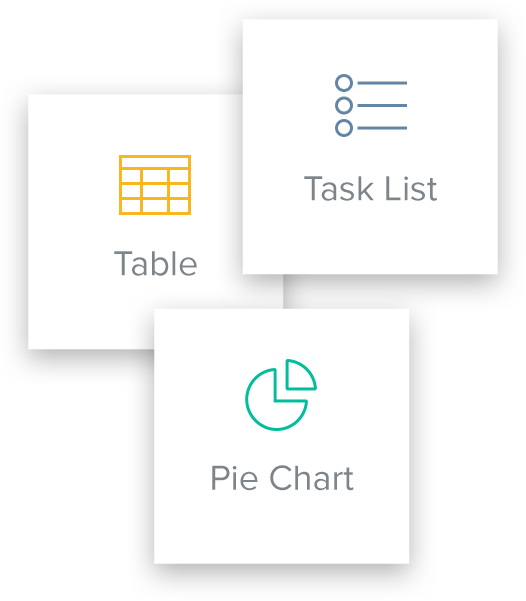How to Make a One Pager
(With Template and Examples)
Updated by Xtensio
Describing projects to friends with time to spare is stress-free. Boiling big ideas down on a single webpage — the page you’ll hand to potential investors and team members — is not. This page matters, which makes completing it even harder. That’s why we’re here to walk you through creating an awesome one-page summary for your business. Explore this template.
Xtensio is your team space for beautiful living documents.
Create, manage and share business collateral, easily.
Table of Contents
What is a One Pager?
A One Pager is a written pitch of your company. The summary details the core of your business—what you’re offering, how you’re going about it and why you stand out from the competition—tightly packaged and expertly worded to fit on a single, sleek and captivating webpage. It is a good idea to explore examples of one pagers before creating your own. Others’ examples can also give you one pager layout ideas, too.
Why do I need it?
- Capture interest. Investors see hundreds of pitches every day. Maybe they remember the gist of what was said in presentations, maybe they don’t. One Pagers are formatted to entice, inform and resonate with people. Their structure piques interest, beginning with an captivating cover image, a bold company name and a gripping tagline, then moves into the essentials—positioning, fundraising plans, intended users.
- Identify potholes. If there’s a section of the template you’re not sure how to answer or sparks debate among internal teammates, then this is where you might begin work. Completing the one page summary will help highlight what’s missing in your business plan and what needs closer consideration or revision. Besides a variety of 1 pager examples, you can also check out our Business Model Canvas to capture your business plan in a lean one page diagram.
- Focus decision-making. When sales or marketing teams talk to consumers and when designers build features, they can turn to the one pager for confirmation that their work is supporting the company’s core values and goals. Check out our marketing one sheet examples for more inspiration.
Now it’s your turn.
Here are some tips and tricks for filling in the One Page Summary Template.
Overview Header
Company Name
What’s in a name? For a young company your name is often your first impression with a potential consumer or investor, so it’s important to make sure your name is thoughtfully considered and speaks to your product, service or philosophy. Here are some tips to get you thinking about strong company titles on your onepager:
- Consider the 5-10 rule. “Great companies throughout history had 5 to 10 letters in their name, at least one hard consonant, and many had a repeating letter,” notes entrepreneur and startup consultant Peter Gasca.
- Say it out loud. There’s a running joke on the TV sitcom 30 Rock that Jenna, one of the characters, stars in a film called “The Rural Juror.” On paper, the name is clear and comprehensible, but when spoken out loud, no one has any idea what she’s saying. Make sure your name not only works on paper but also spoken aloud.
- Prepare for social media restrictions. The name of your company is going to be shared in email subject lines, tweets and meta tags. Short, simple, and unique titles shine on social media platforms.
- Secure your name and vanity addresses. You should verify that your name isn’t already trademarked and make sure your name isn’t registered with common social media channels. If your name is available, secure it! Even if you’re not active on the account, you will own the account name, preventing someone else from taking it and creating a site that confuses consumers when they search for your company.
Fast Hack: Ask for impressions! Bounce names off family, friends, baristas at the cafe downstairs—anyone with a fresh set of ears.
Logo
“A company’s logo is its shorthand, a visual cue that tells a story of the brand’s culture, behavior, and values.”
– Su Mathews Hale, senior partner at the New York brand-strategy and design firm Lippincott.
Mathews Hale notes an essential element of any logo in today’s marketplace is that it be recognizable and impactful even when shrunk to the necessary dimensions for mobile devices and small screens. Check out this article on the best corporate logo changes of 2015. It shows company’s former logos side-by-side with their updated versions. The overall trend shows logos becoming simplified and flattened. Matthews Hale, who’s quoted in the article, attributes this trend to the need for logos to be visible, recognizable and clean on mobile devices and small screens.
Tagline
Your tagline should engage people while describing the core value of your product or service. A few tips about writing taglines:
- Keep it short. You’ll have room in other sections to go into detail about the inner workings and background of your product. Keep your tagline brief and direct. YouTube needed just two words — “Broadcast yourself.”
- Communicate with clarity. Business jargon, complicated phrasing and obscure words deter readers. Your tagline should simply convey the benefit of your company, product or service.
- Narrow the focus. The broader your tagline is, the more people will forget about your product. The more focused it is, the more people will think about your product when a specific, real-world scenario occurs. That’s when the tagline is triggered in their minds, and they think about your product. You have to be specific and scenario-driven.
- Make them do a double take. Choose wording that captures readers’ attention and piques their curiosity to learn more about who you are.
- Update your tagline as your company evolves. Whether your business shifts to cater to a certain audience, scraps features to focus on others or switches in-person to on-line sales models, your tagline should reflect these developments.
Social Media
What’s the best way for outside investors and consumers to connect with your company? Maintaining multiple social media accounts takes time and thought. Make sure you’re on the sites that will get you the most traction, then focus your energy on building a following and maintaining it.
Don’t forget! Set custom URLs for your company. Even if it’s just a social media platform, people should have a way of easily locating your company on every platform.
Positioning
Positioning Statement
A positioning statement is a one or two-sentence declaration that communicates your brand’s unique value to your customers in relation to your main competitors. The goal is to create a unique impression in the customer’s mind so that he or she associates something specific and desirable with your brand that is distinct from rest of the marketplace. Positioning statements are useful for internal decision-making, as they guide and unite the marketing, sales and development teams’ choices. A positioning statement helps you make key decisions that affect your customers’ perception of your brand.
Careful! Your tagline is not your positioning statement. A tagline is an external statement used in your marketing efforts. Insights from your positioning statement can be turned into a tagline, but it is important to distinguish between the two.
Highlight your company’s unique value by using this positioning exercise:
For (your target customer) who (has a specific need or opportunity), (your product or service) is a (type of product category) that (supplies this benefit). Unlike (competitors), (your product) (has this unique advantage).
If you’re having trouble forming your positioning statement, you may need some help to determine how to position yourself in the market and in the mind of your consumers. Try Xtensio’s Brand Positioning Canvas and check out this helpful article on how to nail your positioning. You can also explore the user persona template and other strategy exercises to help find your market fit.
Here are some questions to ask to determine if your positioning statement is working.
Does your positioning statement:
- Differentiate your brand from your competitors?
- Match customer perceptions of your brand?
- Enable growth?
- Identify your brand’s unique value to your customers?
- Express your brand promise as believable and deliverable?
Is your positioning statement:
- Focused on your core customers?
- Memorable and motivating?
- Easy to understand?
- Difficult to copy?
Will your positioning statement:
- Withstand counterattacks from your competitors?
- Help you make more effective marketing and branding decisions?
Product/Service Summary
Core Offering
Introduce your product or service with a description of your core offering. Elaborate on your positioning statement. Include a description of what it is, who it’s for, why it’s needed and why it’s better than other products or services. The summary sections help you elaborate on the problem faced by your consumers and how your product provides a solution.
Milestones and Funding Goals
A Brief Timeline
Highlight your company’s major accomplishments. This section offers readers a quick understanding of your business’s timeline, where and when you started, the path you’ve taken and where you currently stand in terms of users, features, funding, employees, community recognition etc. Increased number of users, increased revenue and additional services prove that:
- You can sell
- You can scale
- You can iterate and develop
- You’re in the right market
- You can attract talent
How Much Money Do You Plan To Raise?
Why do you need a certain amount of funding? How long do you expect your funding to last? Adjust the graph’s legend to illustrate your budget allocations. No matter the stage of your business, if you’re just starting out or thriving in the marketplace investors are going to want to know exactly why and how you’re using their money.
Consider these tips when defining the funding you need:
- Focus on the specific. What are you currently looking to achieve: product development, product/market fit, sales expansion? Know precisely how funds will be applied to get to the next step.
- Run lean. More money is not always better. Particularly if you’re just starting out, working with a strict budget can be useful. It ensures every decision is made with care and all choices are precise, well-researched and efficient. Also, you’ll learn to problem-solve, work within parameters, think outside-the-box and leverage free resources.
- Factor in unexpected fees. Because you never know what issues and opportunities are waiting down the road.
Problems and Solutions
The Problems
What crucial problems do your consumers face today?

Quick tip! Avoid writing down high-level problems. These tend to be obvious, too large in scope, and difficult to achieve. Yes, people in real estate want to sell real estate. Get more specific.
If your consumers have no problems, no frustrations, no desires—this is a problem. It means you have nothing to offer them and, therefore, you don’t have a business. Problems lead to working business models.
Here are some questions to ask to determine if your positioning statement is working.
Careful! Identifying the wrong problem is a problem. If your Problems section is skewed, everything else on the document will be too—your positioning, solutions, fundraising goals, etc.
The Solutions
What makes your company best suited for providing solutions?
Present the features and capabilities that define your service and make it the top tool for addressing consumers’ needs. Your solutions should specifically address the problems you listed on the one pager and should clearly explain how they help your consumers overcome them.
FAQs
Frequently Asked Questions
What elements of your business do you anticipate raising the most concern? Think from an outsider’s perspective by anticipating points of confusion and red flags. Consider elements of your business that you haven’t explained elsewhere on the one pager.
Core Team
The Face Of Your Business
Investors aren’t just signing on to work with a company, they’re signing on to work with people. In this section, humanize your company by providing relevant information about yourself and your teammates.
This section is also useful when onboarding employees. It will give them a quick and clear impression of the people at the core of the business—individuals they’ll be supporting and helping steer the company.
Bonus Resource! Check out this list of 8 types of photos you should never use as professional profile pictures. Just as you should avoid certain images when deciding on a LinkedIn photo, you should follow the same guidelines when selecting images for one pagers, websites and other work-related platforms.
Email Collection
Building An Email Base
You’ll want to keep track of everyone who expresses interest in your business. Attracting potential investors, users, employees, and journalists require communication. By collecting email addresses, you can reach out with updates, invitations, and product launches. As you’re growing and refining certain areas of your business, send out questionnaires, surveys, and personal inquiries to better understand the people who are interested in your company. Particularly after pitching to investors, you’ll want to follow up to thank them for considering your business and to gauge their interest. If you don’t send an email to touch base—you’ve missed an opportunity.
Pro tip: You can also use the landing page template to test a specific idea or measure interest and collect email address. And if you’re looking for a print-friendly version of the one pager, check out the fact sheet template, which is a more condensed version of the executive summary and was created to fit on a single printed page.
Final Thoughts
Bringing It All Together
The One Pager Builder is not set in stone. Like other Xtensio tools, the executive summary should be repurposed, revisited and revised. Startups frequently use one pagers to make sure their efforts are aligned with their vision. But the template can also work well for established companies, small businesses and others. Ultimately, the goal of the one page summary is to succinctly convey your message to your target audience: be it potential investors, users or employees.
BONUS: To make a winning case for potential customers create a digital brochure.

